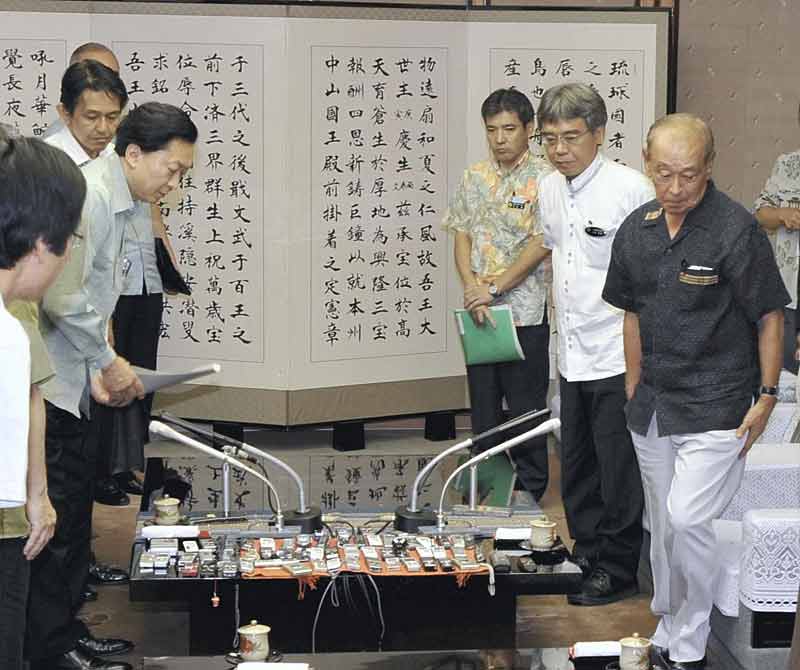Okinawa 50 years since return: National political affairs / Hatoyama’s failure to fulfill campaign pledge dealt heavy blow

Then Okinawa Gov. Hirokazu Nakaima, right, leaves after Prime Minister Yukio Hatoyama told him of the government’s return to the Henoko agreement on May 23, 2010, at the Okinawa prefectural government office in Naha.
The Yomiuri Shimbun
13:28 JST, March 26, 2022
This year marks the 50th anniversary of Okinawa’s return to Japan. This is the fifth installment of a series that looks at the politics surrounding Okinawa’s subsequent development and issues relating to the presence of U.S. bases.
At the Prime Minister’s Office on May 20, 2010, a discussion on relocating a U.S. base in Okinawa became heated.
“What are you going to do if you don’t make a decision today?” Toshimi Kitazawa, the defense minister at the time, recalled shouting at Prime Minister Yukio Hatoyama and other members of the Cabinet. “The Japan-U.S. relationship is spinning out of control.”
The U.S. base in question was the U.S. Marine Corps’ Air Station Futenma in Ginowan.
Kitazawa was irritated by the indecisive attitude of Hatoyama and the rest of the Democratic Party of Japan-led administration.

Toshimi Kitazawa
In his diary entry from that day, he wrote: “At this stage, they are still unmotivated to reach an agreement with the United States. At the end of May, what will they do?”
The end of May was Hatoyama’s self-imposed deadline to settle the Futenma relocation issue.
This deadline has its roots in Hatoyama’s remarks as party leader at a rally in Okinawa in July 2009, before the general election the DPJ won in a landslide to unseat the Liberal Democratic Party. He said then that if he became prime minister, he would relocate the Futenma facility “at least outside the prefecture.”
That meant the 2006 plan agreed upon by Japan and the United States to relocate the base to the Henoko district of Nago would then need to be reviewed.
Seiji Maehara, in charge of the government’s pledges in the field of security policy as a member of the DPJ leadership, was troubled: “After our leader pledges that, we take over the government. But this issue is likely to be prolonged.”
Maehara’s concerns were right on target. Hatoyama became prime minister and hurried to select a relocation site for the Futenma base, but it proved difficult to find a place because most of the candidate sites had already been considered and rejected.
When U.S. President Barack Obama visited Japan in November 2009, Hatoyama said, “Trust me,” though he had no firm prospects on the relocation issue.
Kitazawa thought that the Hatoyama Cabinet should return to the already agreed upon Henoko plan as soon as possible, considering that a promise between nations is significant and that trust will be damaged if it is broken.
At the end of 2009, however, Hatoyama, mistrustful of the foreign and defense ministries as they placed great importance on the Japan-U.S. agreement, entrusted Chief Cabinet Secretary Hirofumi Hirano with the task of dealing with the issue.
Hirano drew up blueprints of potential sites for airfields in the chief cabinet secretary’s office at the Prime Minister’s Office. Hirano took into account about 40 candidate sites, including Tokunoshima island in Kagoshima Prefecture. At the end, none of the candidate sites were selected.
On May 23, 2010, Hatoyama flew to Okinawa to inform Gov. Hirokazu Nakaima of the “heartbreaking decision” to return to the Henoko plan.
Recalling that moment, Nakaima, who had hopes for the Futenma base’ relocation out of the prefecture, said, “All the people of Okinawa felt anger, including those of us who felt we had almost no choice but to accept the Henoko plan.”
It was more than eight months since the Hatoyama administration was launched. Hatoyama’s pledge to the people of Okinawa to move the U.S. base “at least outside the prefecture” ended up being empty words.
The cost of not fulfilling the pledge was heavy. The Hatoyama Cabinet ended and the distrust of the central government among the people of Okinawa grew after they had been struck this blow by the Hatoyama administration’s policy change. That sparked a movement against the Henoko relocation, which further deepened divisions within the prefecture.
Popular Articles
Popular articles in the past 24 hours
-

AI Personalizes Foreign Language Lessons in Pilot Projects, Inspi...
-

Bank of Japan Considered U.S. Tariffs, Coming Shunto Wage Hike Ta...
-

Green Expo 2027 Gains Attention from Osaka Expo Fans; Event Plann...
-

Japan's 1st Domestically Manufactured EV Police Motorcycle Unveil...
-

Kumamoto: Trams to Continue Accepting IC Cards after Strong Oppos...
-

Yen Weakens against Peers after BOJ Raises Interest Rates
-

Coffee Omakase Is Japan's Love Letter to Caffeine
-

Colorful New Year Lucky Charm Production Reaches Peak in Shizuoka...
Popular articles in the past week
-

University of Tokyo Professor Discusses Japanese Economic Securit...
-

Tsukiji Market Urges Tourists to Avoid Visiting in Year-End
-

Israeli Tourists Refused Accommodation at Hotel in Japan’s Nagano...
-

China to Impose Sanctions on Shigeru Iwasaki, Former Head of Japa...
-

Japan to Support Central Asian Logistics Route That Bypasses Russ...
-

U.S. Senate Resolution Backs Japan, Condemns China's Pressure
-

Speed Skater Yukino Yoshida Clinches Ticket to Milan
-

Kenta Maeda Joins Rakuten Eagles; Returns from American MLB to Ja...
Popular articles in the past month
-

Keidanren Chairman Yoshinobu Tsutsui Visits Kashiwazaki-Kariwa Nu...
-

Imports of Rare Earths from China Facing Delays, May Be Caused by...
-

Japan Exports Rise in October as Slump in U.S. Sales Eases
-

University of Tokyo Professor Discusses Japanese Economic Securit...
-

Japan Pulls out of Vietnam Nuclear Project, Complicating Hanoi's ...
-

Govt Aims to Expand NISA Program Lineup, Abolish Age Restriction
-

Blanket Eel Trade Restrictions Rejected
-

Key Japan Labor Group to Seek Pay Scale Hike
"Society" POPULAR ARTICLE
-

M4.9 Earthquake Hits Tokyo, Neighboring Prefectures
-

M7.5 Earthquake Hits Northern Japan; Tsunami Waves Observed in Hokkaido, Aomori and Iwate Prefectures
-

Tsukiji Market Urges Tourists to Avoid Visiting in Year-End
-

Israeli Tourists Refused Accommodation at Hotel in Japan’s Nagano Pref., Prompting Protest by Israeli Embassy and Probe by Prefecture
-

M5.7 Earthquake Hits Japan’s Kumamoto Pref., Measuring Upper 5 Intensity, No Tsunami Expected
JN ACCESS RANKING
-

Keidanren Chairman Yoshinobu Tsutsui Visits Kashiwazaki-Kariwa Nuclear Power Plant; Inspects New Emergency Safety System
-

Imports of Rare Earths from China Facing Delays, May Be Caused by Deterioration of Japan-China Relations
-

University of Tokyo Professor Discusses Japanese Economic Security in Interview Ahead of Forum
-

Japan Pulls out of Vietnam Nuclear Project, Complicating Hanoi’s Power Plans
-

Govt Aims to Expand NISA Program Lineup, Abolish Age Restriction







